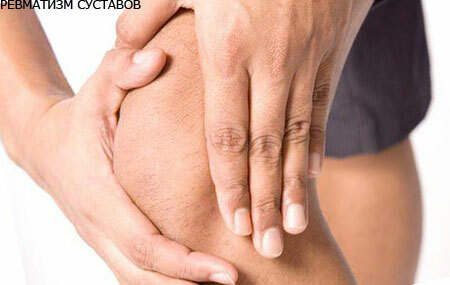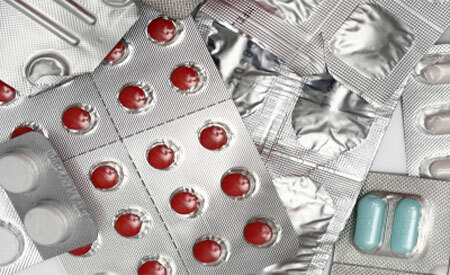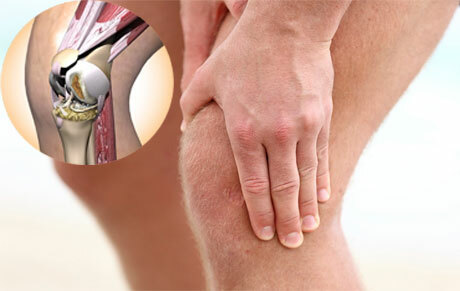"Rheumatism licks joints, but bites the heart"
( expression of old doctors)
If you come to the clinic and listen to patients waiting for a doctor, you can hear various interesting diagnoses: "chamber", "sciatica", and finally "rheumatism".At the present time, however, this word is increasingly used in official medical records.
Earlier rheumatism suffered people, whose work was in a damp and cold climate. Finally, the brave soldier Švejk already at the very beginning of the novel rubs his knees, as he suffers from rheumatism. What are we talking about?
Contents
- 1 Rheumatism of the joints, what is it?
- 2 Reasons for the development of rheumatism
- 2.1 Risk factors
- 3 Symptoms of joint rheumatism
- 4 Treatment of joint rheumatism
- 4.1 Complications of rheumatism
- 5 Prevention of rheumatism of joints
Rheumatism of the joints, what is it?

With rheumatism in our country for a long time reigned diagnostic confusion. Judge for yourself: the ending "- ism" in medicine means "like, striving."For example, "meningism" is a syndrome of irritation of the meninges, but not meningitis, since there is no inflammation. Parasitism is a way of life whose purpose is to become a parasite. What, then, "seeks" rheumatism?
In translation from Greek, "rheumatic" is the process of spreading, pouring, dissolving( on the body).That is again it is not clear: so in fact it is possible to name both process of reception of a medicine, and drink, and distribution of a fever. The latter is closer to the truth, because in the world literature the name "acute rheumatic fever" is accepted.
It was encountered in an era when people lived without antibiotics, but now appears quite rarely. This condition with periodic fever, damage to the heart, joints, brain. Russian doctors called her Sokolsky's disease - Buyo.
In the modern sense, rheumatism is a lesion of the connective tissue of the body, heart and joints caused by β - hemolytic group A streptococcus.
Causes of rheumatism development.
This streptococcus is very "quirky".It can exist in healthy people, nasopharynx. He causes a face, which is still treated with a red rag. It causes streptoderma, scarlet fever in children and unhealthy adults, a variety of angina.
This pathogen is armed with erythrotoxin, enzymes of blood destruction, it successfully dies from antibiotics, but rapid diagnosis of rheumatism is difficult( PCR, ELISA).The fact is that in this group of streptococci there are more than 80 "relatives" that are similar to each other, and it is impossible to guess in advance whether they cause hemolysis( blood destruction), until it starts.
Therefore, the diagnosis of streptococcal lesions is carried out, like dozens of years ago: a smear is sown on blood agar obtained from lamb's blood, then incubated in a thermostat. After the colonies of pure culture have grown, bright rings can be seen along the edges - hemolysis areas.
Risk Factors
In order to develop rheumatism of the joints, it is not necessary to try much. It is enough that the following situations arise:
- carriage of this streptococcus with frequent sore throats, pharyngitis;
- "untreated" ARVI;
- impaired immune response: autoimmune diseases - in fact erythrotoxin can cause an increase in vascular permeability, which is similar to an allergic reaction;
- hereditary predisposition;
- hypothermia, dampness, frequent colds.
Symptoms of joint rheumatism

The main sign that rheumatism can "boast" is the suddenness and volatility of joint damage. It appears as a night assault during a special operation: after a sore throat or banal pharyngitis, which they forgot to think about, suddenly a joint damage occurs, and in turn, one by one.
So, rheumatism of the joints of the feet often begins with a knee joint lesion. The time of rheumatic attacks lasts, on average, 10-12 days, after which the inflammatory phenomena in the joint subside, but the "relay" takes the next joint. Sometimes with the legs the process is suddenly thrown on the hands and it can never be foreseen what joint will be the "next victim".
Most often affected are wrist, knee, elbow and ankle joints, which "break out" in turn. More rarely - hip.
Small joints of the hand, feet with rheumatism almost do not suffer. When a lesion is most likely a diagnosis of rheumatoid arthritis( this is another disease) or psoriatic arthritis. And the spine is not affected at all. How is the joint syndrome manifested?
Rheumatism of the knee joint, the symptoms of which we will consider, can be applied to other localizations:
- Redness of the skin over the joint;
- Appearance of the joint edema, the joint "swells";
- Increased temperature over the joint area, feeling hot;
- Pains. With this lesion, the joint begins to ache and with increasing load the pain increases, and during rest decreases. With arthrosis, on the contrary, there is a "starting" pain at the beginning of the movement, and then the joint "paces" and the pain disappears;
- Violation of the function of the joint: the limitation of the volume of movements.
Usually doctors note dissociation: pains are quite strong, and externally signs of inflammation are not very pronounced.
The older the patient's age, the less joints are involved in the rheumatic process. A situation is possible in which monoarthritis occurs, or only one joint, for example, the knee, is affected. In this case, it is necessary to exclude tuberculosis, which is also characterized by the defeat of one joint, and most often, it is the knee.
There is no change in the examination of the joint by X-ray examination.
It should be noted that such "rheumatic attacks" threaten the heart, and sooner or later the same "arthritis" of the heart will develop. Only the defeat of his tissues is called rheumatic carditis.
In the mild course of the disease, it is asymptomatic, but then signs of heart failure are added: shortness of breath, first with exercise, and then at rest, swelling on the legs and other unpleasant symptoms associated with reduced myocardial contractility.
In addition, joint damage is accompanied by fever, which resembles acute rheumatic fever.
In some cases, no sign of arthritis is detected, other than pain. This arthralgic syndrome, which is completely reversible, and lasts no more than 10-14 days.
Treatment of joint rheumatism

Treatment of joint rheumatism is the tip of the iceberg. You can not begin to treat the joint without understanding the cause. After the causative agent remains in the body and if you start to treat the knees with ointments, gels or the use of anti-inflammatory drugs, the effect will either not be at all, or it will be temporary and short.
The whole point is that reducing inflammation is a pathogenetic therapy. It certainly applies, but it can become completely unnecessary if the etiotropic treatment is correctly performed, that is, the effect on the cause of the disease - the pathogen.
Therefore, the main remedy for joint rheumatism is that it destroys the pathogen, namely antibiotics. In the event that arthritis is accompanied by general manifestations( fever), then hospitalization in the hospital is necessary.
Antibiotic therapy, surprisingly, is done by penicillin. Despite more than 70-year history of use, streptococci have not yet acquired a pronounced resistance to it. Cephalosporins, macrolides are also used, and in case of resistance, a combination of amoxicillin and clavulanic acid( Amoxiclav) is recommended.
Resistance of streptococcus is caused by an amazing reason: it is helped by "friends".Other microbes can synthesize beta-lactamase, which destroys penicillin. And, although they themselves do not cause the disease, but they are able to so low the concentration of penicillin that it does not affect streptococci.
In addition to antibiotic therapy, the remedies for joint rheumatism belong to the group of nonsteroidal anti-inflammatory drugs, but they should be taken in the second place - only against the background of antibacterial therapy. It is then that their effect will be long and persistent.
Complications of rheumatism
To complications of rheumatism, first of all, include heart disease.
Myocarditis and cardiosclerosis
So, if rheumatic inflammation of the myocardium arises and there is no necessary treatment, the outcome of the disease can be cardiosclerosis, with the replacement of muscle connective tissue. This leads to various violations of conductivity and contractility.
In the case of focal cardiosclerosis, the contractile function of the myocardium is not significantly affected, but in the case of diffuse lesion, it significantly decreases.
As a result, cardiac output decreases, and blood circulation becomes decompensated in a large circle: swelling of the legs, enlargement of the liver, shortness of breath - signs of heart failure are formed.
Dry and exudative pericarditis
Currently, these complications are rare, but among the rural population, taking into account the underdevelopment of the diagnostic base and its remoteness, as well as the low level of medical education of the population, these cases began to arise again.
So, with dry pericarditis, pericardial sheets during the contraction of the heart rub against each other, causing pain and noise. Pain in the heart area is constant.
With exudative pericarditis begins to accumulate effusion in the pericardial cavity. This effusion "separates" the leaflets, and the pain disappears. But instead of pain, the fluid accumulating in the pericardial cavity "contracts" the heart from the outside and dyspnea appears, especially when lying on the back.
For relief, such patients tilt the chest forward, bending. The treatment uses pericardial puncture, with pumping out the fluid and the introduction of special substances.
Pericardial damage often signals that all the membranes of the heart are affected: endocardium( with possible valve disorders), myocardium and pericardium.
Prevention of rheumatism of joints

Prevention of rheumatic fever may be primary and secondary. Primary prevention includes all methods and means that prevent the emergence of rheumatism in the body, and to secondary prevention - the prevention of recurrence of the disease.
Primary prevention includes:
- Strengthening of the body, hardening;
- Control of streptococcal disease and infections;
- Sanitation of sick teeth, foci in the throat and middle ear, nasopharynx( otitis, pharyngitis, tonsillitis, sinusitis);
- No supercooling;
- Complete treatment of colds in case of their occurrence.
The tasks of secondary prevention include "suppression" of streptococcal infection within the body.
After eliminating the attack on joints it is recommended to repeat the preventive course in order to avoid relapse, monthly with penicillin drugs, and this should be done for several years. This is done if, in addition to the symptoms of joint damage, there was rheumatic fever, and( or) heart damage.
It is regrettable, but even after 5 years of monthly prophylaxis, its cancellation is again capable of giving repetitions of rheumatic attacks in 10% of patients.
Therefore, at present, prevention is extended to 10 years, and in the case of rheumatic carditis - even before the patient reaches 60 years of age. That is, in fact, it makes sense to conduct lifelong prevention.
Rheumatism of the joints, the symptoms and treatment of which we have described, is never an isolated process. Therefore, it can affect many organs, and, first of all, the heart. At the slightest suspicion of a streptococcal cause of arthritis, urgent treatment should be started, as well as a heart examination.



